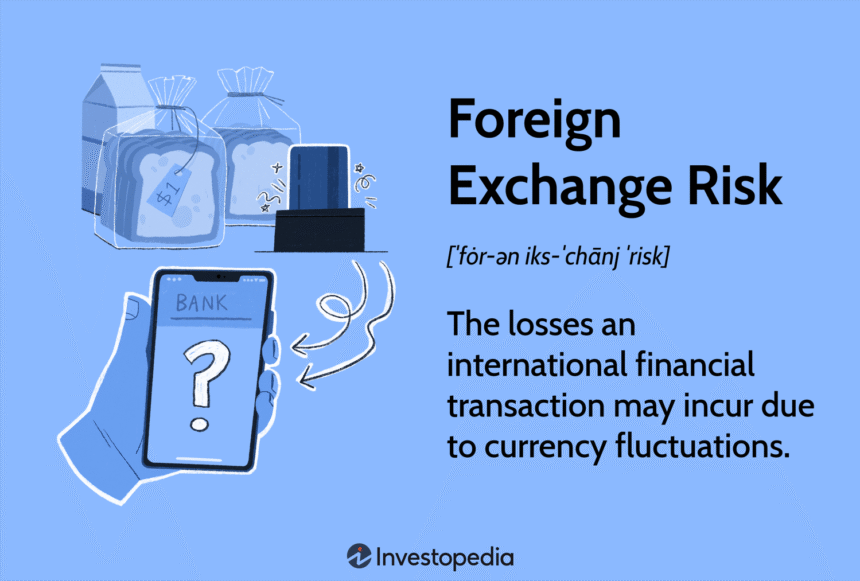- What Is Foreign Exchange Risk?
- How Foreign Exchange Risk Affects International Transactions
- Exploring the Three Types of Foreign Exchange Risk
- How Can an Investor Avoid Foreign Exchange Risk?
- How Can a Company Selling Goods Abroad Avoid Foreign Exchange Risk?
- What Are the Different Types of Foreign Exchange Risk?
- The Bottom Line
What Is Foreign Exchange Risk?
Foreign exchange risk refers to the losses that a business conducting international transactions can incur due to fluctuations in currency rates.
Currency fluctuations can alter business costs and investment values. Examples include changing the real costs of goods ordered from abroad or delivered to a foreign customer, or increase the cost of a planned expansion in a foreign country. Investments in foreign companies can suffer losses due entirely to exchange rate changes. There are three different types of currency risks: transaction, translation, and economic.
Foreign exchange risk is also called currency risk, FX risk, or exchange-rate risk.
Key Takeaways
- Foreign exchange risk can impact businesses and investors engaging in international transactions by causing unexpected financial losses due to fluctuating currency rates.
- There are three primary types of foreign exchange risk: transaction risk, translation risk, and economic risk, each affecting companies and investors differently.
- Hedging strategies, such as forward contracts and options, can help companies manage foreign exchange risk by locking in exchange rates for future transactions.
- Companies that deal with international markets often mitigate foreign exchange risk by quoting prices in their home currency or using financial instruments to hedge.
Investopedia / Julie Bang
How Foreign Exchange Risk Affects International Transactions
Foreign exchange risk occurs when a company makes financial transactions in a foreign currency. Any appreciation or depreciation of the base currency or the appreciation or depreciation of the denominated currency will alter the cash flows emanating from that transaction.
Foreign exchange risk can also affect investors who trade in international markets and businesses engaged in the import/export of products or services to multiple countries.
The proceeds of a closed trade, profit or loss, are in the foreign currency and must be converted back to the investor’s home currency. Exchange rate fluctuations can lower the amount when converting back to the home currency.
An import/export business is exposed to foreign exchange risk by having account payables and receivables affected by currency exchange rates.
This risk arises when a contract specifies exact prices and delivery dates for goods or services. If currency value changes between signing and delivery, one party will incur a loss.
Exploring the Three Types of Foreign Exchange Risk
There are three types of foreign exchange risk:
- Transaction risk: This is the risk that a company faces when it buys a product from a company located in another country. The price of the product will be denominated in the selling company’s currency. If the selling company’s currency appreciates versus the buying company’s currency, the company doing the buying will have to make a larger payment in its base currency to meet the contracted price.
- Translation risk: A parent company might face losses when converting a foreign subsidiary’s financial statements back to its own currency.
- Economic risk: Also called forecast risk, this occurs when a company’s market value is continuously impacted by unavoidable exposure to currency fluctuations.
Companies that are subject to FX risk can implement hedging strategies to mitigate that risk. This usually involves forward contracts, options, and other exotic financial products. If done properly, these strategies can protect the company from adverse foreign exchange moves.
A Real-Life Example of Foreign Exchange Risk
An American liquor company signs a contract to buy 100 cases of wine from a French retailer for €50 per case, or €5,000 total, with payment due at the time of delivery.
The American company agrees to this contract at a time when the Euro and the US Dollar are of equal value, so €1 = $1. Thus, the American company expects that when they accept delivery of the wine, they will be obligated to pay the agreed-upon amount of €5,000, which at the time of the sale was $5,000.
However, it will take a few months for the wine to be delivered. In the meantime, due to unforeseen circumstances, the value of the US dollar has depreciated versus the euro. By the time the wine is delivered, €1 = $1.10.
The contracted price is still €5,000, but now the US dollar amount that the American importer must pay is $5,500.
How Can an Investor Avoid Foreign Exchange Risk?
An investor who wants exposure to foreign companies cannot entirely avoid foreign exchange risk, but there are ways to keep it to a minimum.
One way is to invest in hedged exchange-traded funds (ETFs) that focus on international stocks and bonds. The hedge fund manager will hedge against currency risk through various means available in the forex.
Another way is to invest in the stocks of American companies that are aggressively expanding abroad. Those companies will deal with the foreign exchange risk for you.
How Can a Company Selling Goods Abroad Avoid Foreign Exchange Risk?
If you’re selling goods to foreign markets, the easiest way to reduce foreign exchange risk is to quote your prices and require payment in U.S. dollars, according to the U.S. International Trade Administration. That puts all the risk on your customer and could result in lost opportunities as potential customers look for more accommodating sources.
Another relatively easy strategy for reducing risk, the administration says, is to arrange for a forward contract, which guarantees a pre-set exchange rate at a specific future date. An international banker can advise on the specifics.
What Are the Different Types of Foreign Exchange Risk?
There are at least three types of foreign exchange risk, all of which are related to the effects of fluctuating currency rates:
- The most common risk for any business that exports or imports products is transaction risk. This is the risk that the relative values of two currencies will change between the time the contract is written and the time the goods are delivered. One of the two parties will benefit, and the other will lose.
- Translation risk is faced by any company that has a subsidiary operating in another country. The subsidiary will do business in its home currency, but the numbers in its financial reports to the parent company will fluctuate with its currency value.
- Economic risk is more general. The market value of any global company is continuously fluctuating for better or worse due to currency rate changes.
The Bottom Line
Investors need to understand foreign exchange risk and how it is a potential challenge for businesses and investors involved in international operations. There are three main types of foreign exchange risk: transaction, translation, and economic risk.
One strategy for managing foreign exchange risk is the use of hedging instruments such as forward contracts and options to protect against adverse currency movements. Investors can mitigate exposure by considering hedged ETFs or investing in companies that manage foreign exchange risk effectively. Managing foreign exchange risk is crucial for companies engaged in import/export activities to avoid unexpected costs and protect profit margins. An ongoing awareness and proactive financial planning are vital for minimizing the impact of currency fluctuations on business operations and investments.




















